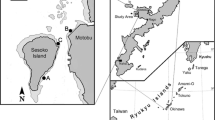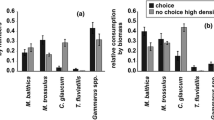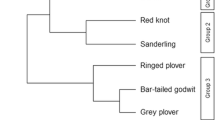Abstract
We performed field and laboratory studies to investigate how large adult Leptasterias polaris detect and locate their major prey, large infaunal bivalves, in the sediment bottom community. A field survey using SCUBA diving showed that 95% of the locations where L. polaris dug into the sediment bottom were over bivalves and this success rate was much greater than if digging was done at random (22%). Furthermore, when sea stars were provided with a low density of randomly distributed prey in a laboratory arena, they dug exclusively in locations where a clam had been buried. These observations indicated that L. polaris locates infaunal prey prior to investing energy into digging. Studies in a laboratory flow tank showed that L. polaris readily detected and moved towards its preferred prey Ensis directus whereas its responses to less preferred prey Mya truncata and Spisula polynyma were much weaker. The degree to which it oriented towards these three common prey seemed to reflect potential energy intake relative to foraging costs (which likely increase with the depth of the different prey) and risks from interactions with other carnivores (which are greatest when feeding on large prey). This is the first study to clearly demonstrate that sea stars use prey odours to locate infaunal prey.



Similar content being viewed by others
References
Allen PL (1983) Feeding behaviour of Asterias rubens (L.) on soft bottom bivalves: a study in selective predations. J Exp Mar Biol Ecol 70:79–90
Anger K, Rogal U, Schriever G, Valentin C (1977) In-situ investigations on the echinoderm Asterias rubens as a predator of soft-bottom communities in the western Baltic Sea. Helgol Wiss Meeresunters 29:439–459
Ansell AD (1969) Leaping movements in the Bivalvia. Proc Malacol Soc Lond 38:387–399
Arima K, Hamaya S, Miyakawa Y (1972) Feeding behaviour of starfish to bivalves. Sci Rep Hokkaido Fish Exp Stn 14:63–69
Batschelet E (1981) Circular statistics in biology. Academic, New York
Beddingfield SD, McClintock JB (1993) Feeding behaviour of the sea star Astropecten artiulatus (Echinodermata: Asteroidea): an evaluation of energy efficient foraging in a soft-bottom predator. Mar Biol 115:669–676
Castilla JC (1972) Responses of Asterias rubens to bivalve prey in a Y-maze. Mar Biol 12:222–228
Christensen AM (1970) The feeding biology of the sea-star Astropecten irregularis Pennant. Ophelia 8:1–134
Dale J (1997) Chemosensory search behaviour in the starfish Asterias forbesi. Biol Bull 193:210–212
Doering PH (1974) A burrowing response of Mercenaria mercenaria (Linneaus, 1758) elicited by Asterias forbesi (Desor, 1848). Veliger 19:167–175
Doering PH (1981) Observations on the behaviour of Asterias forbesi feeding on Mercenaria mercenaria. Ophelia 20:169–178
Emlen JM (1966) The role of time and energy in food preference. Am Nat 100:611–617
Emlen JM (1968) Optimal choice in animals. Am Nat 102:385–389
Gaymer CF, Himmelman JH, Johnson LE (2001a) Use of prey resources by the seastars Leptasterias polaris and Asterias vulgaris: a comparison between field observations and laboratory experiments. J Exp Mar Biol Ecol 262:13–30
Gaymer CF, Himmelman JH, Johnson LE (2001b) Distribution and feeding ecology of the seastars Leptasterias polaris and Asterias vulgaris in the northern Gulf of St. Lawrence, Canada. J Mar Biol Assoc UK 81:827–843
Gaymer CF, Dutil C, Himmelman JH (2004) Prey selection and predatory impact of four major sea stars on a soft bottom subtidal community. J Exp Mar Biol Ecol
Himmelman JH (1991) Diving observations of subtidal communities in the northern Gulf of St. Lawrence. In: Therriault JC (ed) The Gulf of St. Lawrence: small ocean or big estuary? Can Spec Publ Fish Aquat Sci 113:319–332
Himmelman JH, Dutil C (1991) Distribution, population structure and feeding of subtidal seastars in the northern Gulf of St. Lawrence. Mar Ecol Prog Ser 76:61–72
Hughes RN (1980) Optimal foraging in the marine context. Oceanogr Mar Biol Annu Rev 18:423–481
Huxley CJ (1976) Response of Acanthaster planci (L.) to partial stimuli. J Exp Mar Biol Ecol 22:199–206
MacArthur RH, Pianka ER (1966) On optimal use of a patchy environment. Am Nat 100:603–609
Mauzey KP, Birkland C, Dayton PK (1968) Feeding behaviour of asteroids and escape responses of their prey in the Puget Sound region. Ecology 49:603–619
McClintock JB, Klinger TS, Lawrence JM (1984) Cheoreception in Luidia clathrata (Echinodermata: Asteroidea): qualitative and quantitative aspects of chemotactic responses to low molecular weight compounds. Mar Biol 84:47–52
Morissette S, Himmelman JH (2000) Subtidal food thieves: interactions of four invertebrate kleptoparasites with the sea star Leptasterias polaris. Anim Behav 60:531–543
Rochette R, Hamel J-F, Himmelman JH (1994) Foraging strategy of the asteroid Leptasterias polaris: role of prey odours, current and feeding status. Mar Ecol Prog Ser 106:93–100
Schoener TW (1971) Theory of feeding strategies. Annu Rev Ecol Syst 2:369–404
Sloan NA, Northway SM (1982) Chemoreception by the asteroid Crossaster papposus (L.). J Exp Mar Biol Ecol 61:85–98
Smith LS (1961) Clam-digging behaviour in the starfish, Pisaster brevispinus (Stimpson 1857). Behaviour 18:148–153
Swenson DP, McClintock JB (1998) A quantitative assessment of chemically-mediated rhetotaxis in the asteroid Coscinasterias tenuispina. Mar Freshw Behav Physiol 31:63–80
Van Veldhuizen HD, Phillips DW (1978) Prey capture by Pisaster brevispinus (Asteriodea: Echinodermata) on soft substrate. Mar Biol 48:89–97
Weissburg MJ (2000) The fluid dynamical context of chemosensory behaviour. Biol Bull 198:188–202
Weissburg MJ, Ferner MC, Pisut DP, Smee DL (2002) Ecological consequences of chemically mediated prey perception. J Chem Ecol 28:1953–1970
Zafiriou O (1972) Response of Asterias vulgaris to chemical stimuli. Mar Biol 17:100–107
Zar JH (1999) Biostatistical analysis, 4th edn. Prentice Hall, Upper Saddle River, N.J.
Zimmer RK, Butman CA (2000) Chemical signalling processes in the marine environment. Biol Bull 198:168–187
Acknowledgements
We are very grateful to C. Vallières, I. Deschênes, M.-O. Nadon, P. Grondin, and F. Praira for their help during long cold dives and assistance with the laboratory experiments. As well, we thank C. Dumont for his useful suggestions for experimental design. This study was funded by a Natural Sciences and Engineering Research Council of Canada grant to J.H.H.
Author information
Authors and Affiliations
Corresponding author
Additional information
Communicated by R.J. Thompson, St. John’s
Electronic Supplementary Material
Rights and permissions
About this article
Cite this article
Thompson, M., Drolet, D. & Himmelman, J.H. Localization of infaunal prey by the sea star Leptasterias polaris. Marine Biology 146, 887–894 (2005). https://doi.org/10.1007/s00227-004-1497-1
Received:
Accepted:
Published:
Issue Date:
DOI: https://doi.org/10.1007/s00227-004-1497-1




